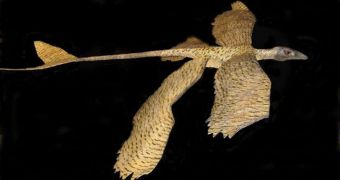Among anthropologists and paleontologists, there has been a longstanding debate as to whether feathered dinosaurs, the early ancestors of modern birds, took to the skies by making longer and longer leaps from the ground, or by jumping off tree branches. A recent investigation appears to have what it takes to settle the debate, as it shows that the arboreal, or tree-based, lifestyle seems to connect more with the habits of the animals than a ground-based living. The research is tremendously important, because it help settle the course of birds' evolution, LiveScience reports.
The new study was focused on Microraptor gui, an ancient, four-legged creature that is considered to be half-bird, and half-dinosaur. In other words, it is a missing link between the two types of animals, so researchers thought it was appropriate to study it over any other fossil. According to dating techniques, the proto-bird appears to have lived about 120 million years ago. It sported bird-like feathers on its body, but its head was clearly that of a dinosaur, featuring scales and long, sharp teeth.
What really puzzled investigators while they were analyzing the creature was the fact that it seemed to have sported 7-inch (18-cm) -long feathers on its hind legs. Previous researches into their functionality revealed that these feathers might have allowed for bipedal, or four-legged walk, but the new study argues that this would have been virtually impossible. “With those big flight feathers on its feet, I can hardly figure out how it could even have maneuvered on the ground at all, because with its legs extended the feathers would have extended too, and they would have been a serious impediment,” the leader of the new study, University of Kansas scientist David Alexander, says.
Working together with colleagues from the Northeastern University in China, the Kansas team developed a plastic model based on the microraptor's fossil, and also added impressions of the feathers the actual animals would have had. The researchers discovered that the creatures had the ability to use their hip bones in a way that allowed them to extend their hind feet sideways, for use as wings. “The controversy was that these animals couldn't spread their hind wings to glide. But we've been able to articulate the bones in their hip socket to show that they could fly,” Kansas researcher David Burnham says.
“It probably would have only come to the ground in emergencies. I'm not sure that [everyone] will be completely convinced, but for me the evidence is pretty ironclad,” Alexander says, adding that, oddly enough, the animals couldn't run on the ground, to steer clear of danger. Modern birds have at least some ability to move about while not airborne, although ineffectively. Further details of this work appear in the January 25 issue of the respected journal Proceedings of the National Academy of Sciences (PNAS).

 14 DAY TRIAL //
14 DAY TRIAL //